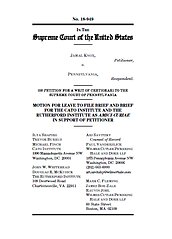Learn more about Cato’s Amicus Briefs Program.
Jamal Knox was arrested on drug-related charges and released pending further court proceedings. During the interim, he created a rap video in which he made disparaging remarks about the police and named two of the officers who arrested him. The Pennsylvania Supreme Court held that the video demonstrated subjective intent to harm under the “true threats” doctrine and imposed a criminal penalty on Mr. Knox.
The First Amendment protects the right of every person to speak freely without fear of punishment; it specifically protects the ability to criticize government officials. Indeed, the Constitution’s protection of speech is at its highest when government attempts to prosecute someone for his spoken words. One narrow exception is the “true threats” doctrine, which allows a government to punish a person for what he says if his words amount to an actual threat of harm, such as a bomb threat. But just how narrow this exception is remains a mystery.
Courts are divided over whether to consider only the speaker’s subjective intent, or the speaker’s intent and the objective nature of the threat—whether a reasonable person would view the speech as a threat. The second standard offers more protection to the speaker, because the government must prove show both subjective and objective elements of a “threat.” Cato, joined by the Rutherford Institute, now asks the U.S. Supreme Court to review this case and ultimately choose the higher standard of protection.
The ambiguity over whether and how the government may criminally prosecute someone for the content of speech is a serious threat to liberty. The situation is more alarming given that the United States is undergoing a communications revolution, driven by unprecedented new forms of online expression—and unprecedented new attempts by government to monitor and restrict such expression. This case presents an opportunity for the Court to set clear boundaries for the government’s authority to limit online expression through criminal prosecution.
The Court really does need to step in to avoid chilling protected expression. The subjective-intent-only test fails to protect defendants who are prosecuted for their speech, insulates “true threats” convictions from appellate review, and leaves controversial speakers unprotected even with respect to political or artistic expression.

This work is licensed under a Creative Commons Attribution-NonCommercial-ShareAlike 4.0 International License.
